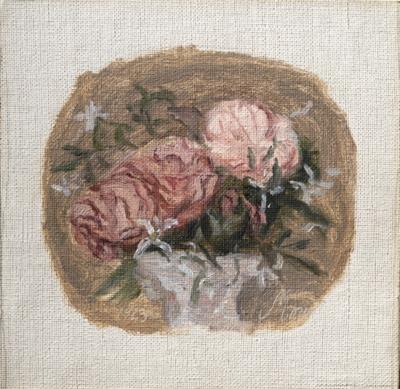Giorgio Morandi *
[Saleroom Notice]
(Bologna 1890–1964)
Fiori, 1943, signed, oil on canvas, 20 x 21 cm, framed
Provenance:
G. Beliossi Collection, Bologna
European Private Collection
Exhibited:
Bologna, Natura ed Espressione nell’Arte Bolognese-emiliana, Palazzo dell’Archiginnasio, 12 September – 22 November 1970, no. 102 with ill.
Rome, Giorgio Morandi, Galleria Nazionale d’Arte Moderna, 18 May – 22 July 1973, no. 76 with ill.
Ferrara, Giorgio Morandi, Palazzo dei Diamanti, 1 July – 8 October 1978 (label on the reverse)
Literature:
L. Vitali, Giorgio Morandi Pittore, Milan, Il Milione, 1964, 1965, 1970, no. 145 with ill.
L. Vitali, Giorgio Morandi, Catalogo generale 1913–1947, Electa, Milan 1977, no. 406 with ill.
Zitat:
“[...] Ah, yes. He is the painter I love the most. The objects he depicts are bathed in a dreamlike light, yet they are painted with a detachment, with a precision, with a rigour that make them almost intangible. You could say it is an art in which nothing happens by chance.”
Federico Fellini, La Dolce Vita, 1960
Dialogue between Marcello and Steiner on Morandi’s painting
“See, in these silences where things
give over and seem on the verge
of betraying their final secret,
sometimes we feel we’re about
to uncover an error in Nature,
the still point of the world, the link that won’t hold,
the thread to untangle that will finally
lead to the heart of a truth.”
Eugenio Montale, 'The Lemons' (1925), from Poems, by Eugenio
Montale. With Translation and Notes by Jonathan Galassi, Everyman’s Library, 1999.
There are artists who have dedicated their entire existence to representing one or very few subjects. For them, these subjects have become distinctive elements of their poetics, but, above all, fundamental tools of ontological and phenomenological investigation.
The father of modern art Paul Cézanne painted the famous Provençal mountain of Saint Victoire for over twenty years, reflecting deeply on the theme of the perception of nature; Alberto Giacometti, freed from the limitations of the “surrealist party” – to use a late expression of Matta’s – focused his study and “excavated” the material extensively in an attempt to capture the most authentic essence of man. Finally, Giorgio Morandi, the great spiritual heir to Cézanne’s visions, who, like the master from Aix, took the everyday as his sole, perpetual iconographic model and explored its apparent predictability.
Morandi’s art is home to a hidden dimension, an inter-space, one whose greatness is contained precisely in the way in which the banal is transfigured into something ancestral, something epiphanic. And if, on the one hand, the latter seems to draw on tradition, on the other, it transposes itself perfectly on a biographical and existential plane: a monastic, secluded painting, like that of Jean Baptiste Chardin, is defined by meditation and silence.
The present work refers to the historical period that the great critic Francesco Arcangeli called “the great season” of landscapes and still lifes from ‘42 to ‘43. Morandi, therefore, who had definitively moved on from the avant-garde experiments of the first phase of his life, was linked to Metaphysical Art, above all.
This work is an extraordinary example of the poetic path pursued by the painter from Bologna. A very minimal colour palette, depicted with opaque and desaturated tints, is used to sketch out a subject that offers itself to the spectator more as an image of the inner mind than an actual representation. Precisely for this reason was it able to reveal – as Walter Benjamin would say – that “unique apparition of a distance” that constitutes the very essence of the Aura.
This work is being offered for sale from an offsite location and is not in Dorotheum, Vienna. The confirmation for the export permission is still pending. This sale is subject to the condition subsequent of the completion of a lawful transport of the object into Austria.
Esperto: Alessandro Rizzi
 Alessandro Rizzi
Alessandro Rizzi
+39-02-303 52 41
alessandro.rizzi@dorotheum.it
23.05.2023 - 18:00
- Prezzo realizzato: **
-
EUR 260.000,-
- Stima:
-
EUR 200.000,- a EUR 300.000,-
Giorgio Morandi *
[Saleroom Notice](Bologna 1890–1964)
Fiori, 1943, signed, oil on canvas, 20 x 21 cm, framed
Provenance:
G. Beliossi Collection, Bologna
European Private Collection
Exhibited:
Bologna, Natura ed Espressione nell’Arte Bolognese-emiliana, Palazzo dell’Archiginnasio, 12 September – 22 November 1970, no. 102 with ill.
Rome, Giorgio Morandi, Galleria Nazionale d’Arte Moderna, 18 May – 22 July 1973, no. 76 with ill.
Ferrara, Giorgio Morandi, Palazzo dei Diamanti, 1 July – 8 October 1978 (label on the reverse)
Literature:
L. Vitali, Giorgio Morandi Pittore, Milan, Il Milione, 1964, 1965, 1970, no. 145 with ill.
L. Vitali, Giorgio Morandi, Catalogo generale 1913–1947, Electa, Milan 1977, no. 406 with ill.
Zitat:
“[...] Ah, yes. He is the painter I love the most. The objects he depicts are bathed in a dreamlike light, yet they are painted with a detachment, with a precision, with a rigour that make them almost intangible. You could say it is an art in which nothing happens by chance.”
Federico Fellini, La Dolce Vita, 1960
Dialogue between Marcello and Steiner on Morandi’s painting
“See, in these silences where things
give over and seem on the verge
of betraying their final secret,
sometimes we feel we’re about
to uncover an error in Nature,
the still point of the world, the link that won’t hold,
the thread to untangle that will finally
lead to the heart of a truth.”
Eugenio Montale, 'The Lemons' (1925), from Poems, by Eugenio
Montale. With Translation and Notes by Jonathan Galassi, Everyman’s Library, 1999.
There are artists who have dedicated their entire existence to representing one or very few subjects. For them, these subjects have become distinctive elements of their poetics, but, above all, fundamental tools of ontological and phenomenological investigation.
The father of modern art Paul Cézanne painted the famous Provençal mountain of Saint Victoire for over twenty years, reflecting deeply on the theme of the perception of nature; Alberto Giacometti, freed from the limitations of the “surrealist party” – to use a late expression of Matta’s – focused his study and “excavated” the material extensively in an attempt to capture the most authentic essence of man. Finally, Giorgio Morandi, the great spiritual heir to Cézanne’s visions, who, like the master from Aix, took the everyday as his sole, perpetual iconographic model and explored its apparent predictability.
Morandi’s art is home to a hidden dimension, an inter-space, one whose greatness is contained precisely in the way in which the banal is transfigured into something ancestral, something epiphanic. And if, on the one hand, the latter seems to draw on tradition, on the other, it transposes itself perfectly on a biographical and existential plane: a monastic, secluded painting, like that of Jean Baptiste Chardin, is defined by meditation and silence.
The present work refers to the historical period that the great critic Francesco Arcangeli called “the great season” of landscapes and still lifes from ‘42 to ‘43. Morandi, therefore, who had definitively moved on from the avant-garde experiments of the first phase of his life, was linked to Metaphysical Art, above all.
This work is an extraordinary example of the poetic path pursued by the painter from Bologna. A very minimal colour palette, depicted with opaque and desaturated tints, is used to sketch out a subject that offers itself to the spectator more as an image of the inner mind than an actual representation. Precisely for this reason was it able to reveal – as Walter Benjamin would say – that “unique apparition of a distance” that constitutes the very essence of the Aura.
This work is being offered for sale from an offsite location and is not in Dorotheum, Vienna. The confirmation for the export permission is still pending. This sale is subject to the condition subsequent of the completion of a lawful transport of the object into Austria.
Esperto: Alessandro Rizzi
 Alessandro Rizzi
Alessandro Rizzi
+39-02-303 52 41
alessandro.rizzi@dorotheum.it
|
Hotline dell'acquirente
lun-ven: 10.00 - 17.00
kundendienst@dorotheum.at +43 1 515 60 200 |
| Asta: | Arte moderna |
| Tipo d'asta: | Asta in sala con Live Bidding |
| Data: | 23.05.2023 - 18:00 |
| Luogo dell'asta: | Wien | Palais Dorotheum |
| Esposizione: | 13.05. - 23.05.2023 |
** Prezzo d’acquisto comprensivo dei diritti d’asta acquirente e IVA
Non è più possibile effettuare un ordine di acquisto su Internet. L'asta è in preparazione o è già stata eseguita.
